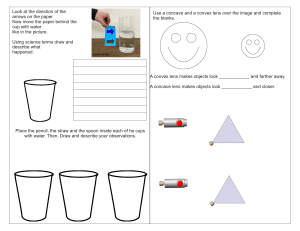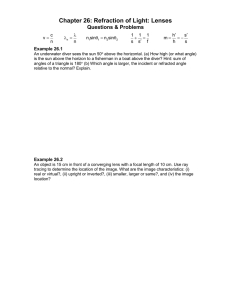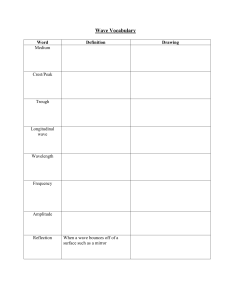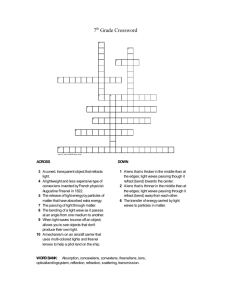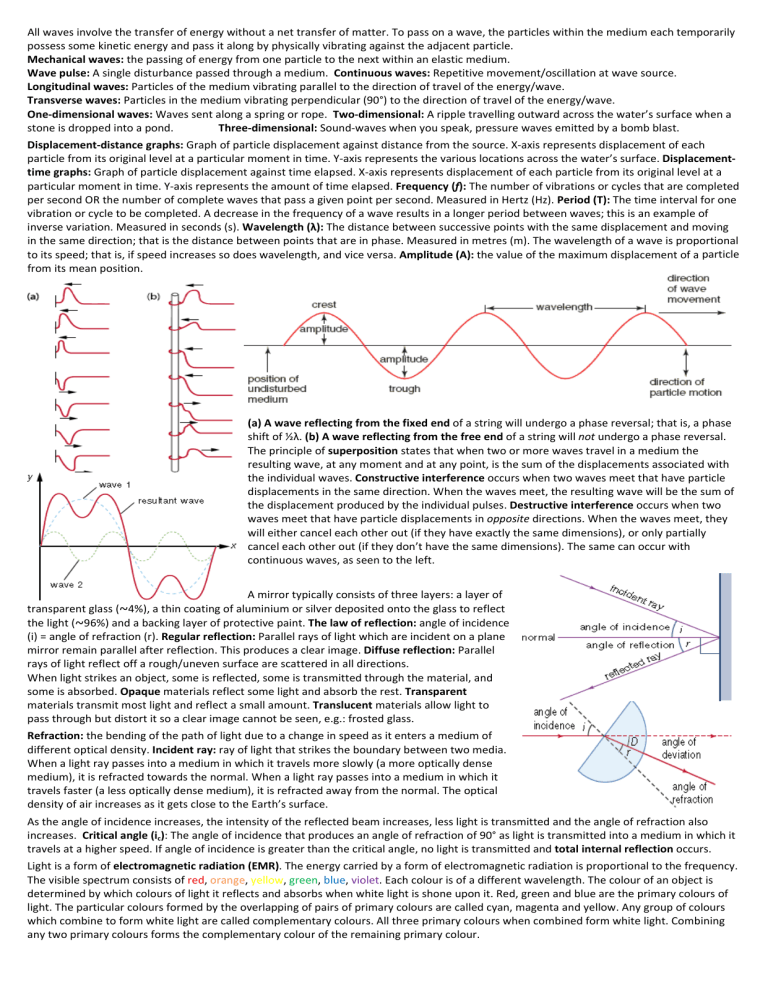
All waves involve the transfer of energy without a net transfer of matter. To pass on a wave, the particles within the medium each temporarily possess some kinetic energy and pass it along by physically vibrating against the adjacent particle. Mechanical waves: the passing of energy from one particle to the next within an elastic medium. Wave pulse: A single disturbance passed through a medium. Continuous waves: Repetitive movement/oscillation at wave source. Longitudinal waves: Particles of the medium vibrating parallel to the direction of travel of the energy/wave. Transverse waves: Particles in the medium vibrating perpendicular (90°) to the direction of travel of the energy/wave. One‐dimensional waves: Waves sent along a spring or rope. Two‐dimensional: A ripple travelling outward across the water’s surface when a stone is dropped into a pond. Three‐dimensional: Sound‐waves when you speak, pressure waves emitted by a bomb blast. Displacement‐distance graphs: Graph of particle displacement against distance from the source. X‐axis represents displacement of each particle from its original level at a particular moment in time. Y‐axis represents the various locations across the water’s surface. Displacement‐ time graphs: Graph of particle displacement against time elapsed. X‐axis represents displacement of each particle from its original level at a particular moment in time. Y‐axis represents the amount of time elapsed. Frequency (f): The number of vibrations or cycles that are completed per second OR the number of complete waves that pass a given point per second. Measured in Hertz (Hz). Period (T): The time interval for one vibration or cycle to be completed. A decrease in the frequency of a wave results in a longer period between waves; this is an example of inverse variation. Measured in seconds (s). Wavelength (λ): The distance between successive points with the same displacement and moving in the same direction; that is the distance between points that are in phase. Measured in metres (m). The wavelength of a wave is proportional to its speed; that is, if speed increases so does wavelength, and vice versa. Amplitude (A): the value of the maximum displacement of a particle from its mean position. (a) A wave reflecting from the fixed end of a string will undergo a phase reversal; that is, a phase shift of ½λ. (b) A wave reflecting from the free end of a string will not undergo a phase reversal. The principle of superposition states that when two or more waves travel in a medium the resulting wave, at any moment and at any point, is the sum of the displacements associated with the individual waves. Constructive interference occurs when two waves meet that have particle displacements in the same direction. When the waves meet, the resulting wave will be the sum of the displacement produced by the individual pulses. Destructive interference occurs when two waves meet that have particle displacements in opposite directions. When the waves meet, they will either cancel each other out (if they have exactly the same dimensions), or only partially cancel each other out (if they don’t have the same dimensions). The same can occur with continuous waves, as seen to the left. A mirror typically consists of three layers: a layer of transparent glass (~4%), a thin coating of aluminium or silver deposited onto the glass to reflect the light (~96%) and a backing layer of protective paint. The law of reflection: angle of incidence (i) = angle of refraction (r). Regular reflection: Parallel rays of light which are incident on a plane mirror remain parallel after reflection. This produces a clear image. Diffuse reflection: Parallel rays of light reflect off a rough/uneven surface are scattered in all directions. When light strikes an object, some is reflected, some is transmitted through the material, and some is absorbed. Opaque materials reflect some light and absorb the rest. Transparent materials transmit most light and reflect a small amount. Translucent materials allow light to pass through but distort it so a clear image cannot be seen, e.g.: frosted glass. Refraction: the bending of the path of light due to a change in speed as it enters a medium of different optical density. Incident ray: ray of light that strikes the boundary between two media. When a light ray passes into a medium in which it travels more slowly (a more optically dense medium), it is refracted towards the normal. When a light ray passes into a medium in which it travels faster (a less optically dense medium), it is refracted away from the normal. The optical density of air increases as it gets close to the Earth’s surface. As the angle of incidence increases, the intensity of the reflected beam increases, less light is transmitted and the angle of refraction also increases. Critical angle (ic): The angle of incidence that produces an angle of refraction of 90° as light is transmitted into a medium in which it travels at a higher speed. If angle of incidence is greater than the critical angle, no light is transmitted and total internal reflection occurs. Light is a form of electromagnetic radiation (EMR). The energy carried by a form of electromagnetic radiation is proportional to the frequency. The visible spectrum consists of red, orange, yellow, green, blue, violet. Each colour is of a different wavelength. The colour of an object is determined by which colours of light it reflects and absorbs when white light is shone upon it. Red, green and blue are the primary colours of light. The particular colours formed by the overlapping of pairs of primary colours are called cyan, magenta and yellow. Any group of colours which combine to form white light are called complementary colours. All three primary colours when combined form white light. Combining any two primary colours forms the complementary colour of the remaining primary colour. Dispersion: The spreading out of the white light into its component colours due to the speed of light for different colours being slightly different in some materials. Unpolarised light: Light that has electric field variations that are not in alignment with one another. Polarised light: Light that has electric field variations in the same plane as one another. Polarising filters have molecules that will block all electric field wave components except those whose plane is aligned in a particular direction. Nature: real/virtual. Orientation: upright/inverted. Position: of image in relation to the mirror. Size: height of image, factor of magnification. Virtual image: image formed behind an optical element (e.g.: mirror), cannot be projected onto a screen. Images formed by plane mirrors are: upright, same distance behind mirror as object is in front of, same size as original. Object Image Concave spherical mirrors Beyond C Between C and F Real inverted Diminished At C At C Real Inverted Same size Between C and F Beyond C Real Inverted Enlarged At F Infinity ‐ ‐ ‐ Between F and P Behind mirror Virtual Upright Enlarged Images produced by a convex mirror are always virtual, diminished and upright. Convex lenses have one or both sides curved outwardly. Concave lenses have one of both sides curved inwardly. Any ray passing through the optical centre of a spherical lens is undeviated. Any ray that travels parallel to the principal axis will be deviated through the principal focus of a convex lens, or deviated so that it appears to have come from the principal focus of a concave lens. Any ray that passes through the principal focus of a convex lens or is directed towards the principal focus of a concave lens will be deviated so that it emerges parallel to the principal axis. Images produced by a concave lens are always virtual, upright and diminished. The closer the object is to the lens, the larger the image is, but it can never be the same size. For the lens equation: f is positive for a convex lens and negative for a concave lens, u is always positive, v is positive if the image is real and negative if the image is virtual. For the magnification equation: the sign of M indicates whether the image is upright (and therefore virtual) (+) or inverted (and therefore real) (‐), Hi is positive if M is, and negative if M is. Aberration is deviation from the perfect image. Spherical aberration is the blurring of an image as a result of rays on the outer edge of a spherical lens having a closer focal point. Chromatic aberration is the spreading of light into its separate colours as a result of the differing focal lengths for each colour. The lens system in a simple camera has a fixed focal length, so when photographing closer objects the lens is moved further from the film. Film speed: amount of a light a film must be exposed to produce a photograph. Shutter speed: how long the shutter stays opening, determining how much light the film/sensor is exposed to. Aperture/f‐stop: the ratio of the focal length to the lens diameter. The refracting telescope is constructed of two convex lenses placed a specific distance apart. The objective lens has a relatively long focal length. The reflecting telescope uses mirrors instead of lenses, these can be supported from behind, are cheaper to produce and are not subject to chromatic aberration. The compound microscope is constructed from two convex lenses. The objective lens is shorter in focal length than the eyepiece lens. Myopia is a condition in which parallel rays from a distant object are brought to a focus in front of the retina, rather than on it. Hypermetropia is a condition in which a person’s lens is too weak to bend rays sufficiently to bring them to a focus at the retina. These conditions are corrected by concave and convex lenses respectively. v=d/t f=1/T T=t/n=1/f v=f∙λ D=i–r n = c / vmedium n* = sin i / sin r = v1 / v2 = n2 / n1 sin ic = n2 / n1 f=c/λ n = (360° / θ) – 1 f=R/2 M = Hi / Ho = ‐v / u (1 / f) = (1 / u) + (1 / v) D=1/f v = speed (m s‐1), d = distance travelled (m), t = time taken (s) f = frequency (Hz), T = period (s) T = period (s), t = time (s), n = no. of waves, f = frequency v = speed (m s‐1), f = frequency (Hz), λ = wavelength (m) D = angle of deviation, i = angle of incidence, r = angle of refraction n = absolute refractive index, c = 3.0x108 m s‐1, vmedium = speed of light in the medium n* = relative refractive index, i = angle of incidence, r = angle of refraction, v1 = speed of light in medium 1, v2 = speed of light in medium 2, n1 = refractive index for medium 1, n2 = refractive index for medium 2 ic = critical angle, n1 = refractive index for medium 1, n2 = refractive index for medium 2 f = frequency of the EMR, c = speed of the EMR (3.0x108 m s‐1), λ = wavelength of the EMR n = number of images formed by two plane mirrors, θ = angle at which mirrors are placed to each other f = focal length, R = radius of curvature M = magnification, Hi = image height, Ho = object height, v = image distance, u = object distance f = focal length, u = object distance, v = image distance D = dioptric power (D or m s‐1), f = focal length D = D1 + D2

